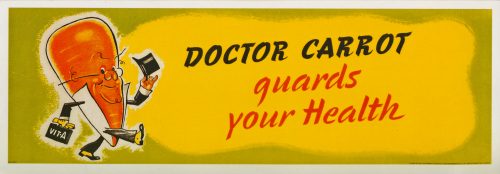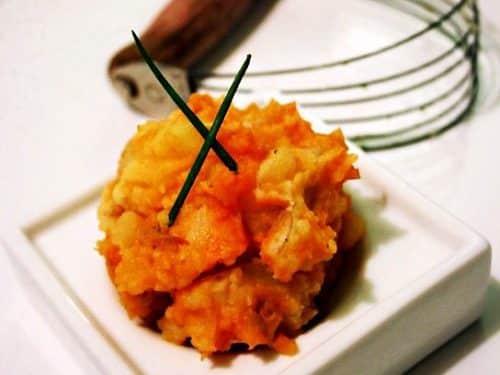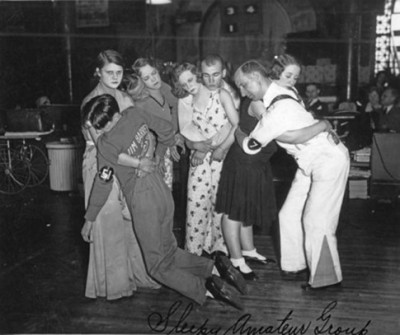Today many countries around the world are paying homage to the fallen soldiers who died in the line of duty, a solemn memorial day commemorating the end of World War I. It is called Armistice Day, Veteran’s Day in the USA, and Remembrance day in the Commonwealth of which Canada is part of.
Times of war are often also times of famine, malnourishment, rations and making due with what you have. Easy things to grow were the backbone of most people’s diets: cabbage, potatoes, carrots, onions. A common dish people served was Carrot Potato Mash. Easy, plain, even boring. I challenged myself give it a modern look as a dedication to every soldier who has ever fought for freedom and human rights.

Carrot and Potato Mash is a dish my mom prepared often when I was a child but I never thought much of it. I hated it and I think most kids did too. I always assumed it was a tragic recipe born out of the 60s and 70s. It never occurred to me until I did a bit of research that this dish, created by soldiers, has historical roots.
The original name is Hutspot, a dish of boiled and mashed potatoes, carrots and onions with a long history in traditional Dutch cuisine. According to legend, the recipe came from the cooked bits of potato left behind by hastily departing Spanish soldiers during their Siege of Leiden in 1574 during the Eighty Years’ War, when the liberators breached the dikes of the lower lying polders surrounding the city. This flooded all the fields around the city with about a foot of water. As there were few, if any, high points, the Spanish soldiers camping in the fields were essentially flushed out.

Speaking of carrots, ever wonder why people say eat your carrots for a better eyesight? Well this myth too dates back to a war. It was actually part of an advertising campaign during the 2nd World War. We do know that carrots are high in Vitamin A and a lack of vitamin A can cause poor vision.
The propaganda actually came from British gunners who had to be able to shoot down German planes at night. The rumor arose in an attempt to cover up the discovery and effective use of radar technologies in engaging enemy planes, as well as the use of red light in aircraft instruments. From this advertising campaign was born the “Doctor Carrot” cartoon who encouraged everyone to grow, and eat carrots and be healthy like soldiers.
In the picture you can see my grandmother’s pastry cutter. I use it to when ever a recipe calls for mashing. Not always the best tool but it has too much symbolic meaning for me.

Carrot Potato Mash
Ingredients
- 2 medium/large potatoes per person
- 1 medium/large carrot per person
- 1 oz butter per person
- salt and pepper to taste
Instructions
- Fill a large saucepan with salted water and bring to a boil.
- Chop potatoes into small pieces and grate carrots, add to boiling water in the saucepan. Simmer for about 15 min, until the potatoes are tender.
- Drain, put back in the saucepan, add butter and mash thoroughly.
- Add salt and pepper to taste and serve.
About a year ago my mom sent me an email with a collection of astounding historical pictures. I always held on to them because one day a post would be a perfect fit for them. It is just an amazing and touching collection of photographs. I have no idea where they originate from, I wish I could give credit. Each one marks an important moment in history. We have to remember so we do not forget!
Please take the time to look at them, it is well worth it.

Jewish refugees, approaching allied soldiers, become aware that they have just been liberated, April, 1945

The Kennedy trio in the mid 30s as teenagers; John, Bobby and Teddy

Martin Luther King Jr removing a burned cross from his front yard with his son at his side. Atlanta Ga 1960

Last four couples standing in a Chicago dance marathon. ca. 1930.

Three Princeton students pose after the Freshman, Sophomore snowball fight. 1893. Princeton, NJ.

“Get the hell out of my race and give me those numbers.” After realizing a woman was running Boston marathon organizer Jock Semple went after Kathrine Switzer. Other runners blocked him and she went on to finish the race. 1967.

The only known photograph of an African American Union soldier with his family. c1863-65

Russian peasants getting electricity for the first time in 1920

Johnny Cash performing for prisoners at Folsom Prison – Jan. 13th 1968

Cow shoes used by Moonshiners in the Prohibition days to disguise their footprints, 1922

“The Long Walk” British Army EOD Tech approaches a suspect device – Date Unknown

Tereska, a child in a residence for disturbed children, grew up in a concentration camp. She drew a picture of “home” on the blackboard, Poland, 1948

A Native American looks down at a newly-completed section of the transcontinental railroad. Nevada, about 1868

Microsoft staff photo from Dec. 7, 1978

New York man reads a newspaper, headline reads “Nazi Army Now 75 Miles From Paris.” May 18, 1940

Three archers, Japan, ca.1860-1900

The earliest known photograph of men drinking beer. Edinburgh Ale, 1844

Alerted by the smell of a broken bottle of liquor, Federal Agents inspect a “lumber truck”. Los Angeles, 1926

A Japanese family returning home (Seattle, Washington) from a relocation center camp in Hunt, Idaho on May 10, 1945

9 kings featured in one photo (Windsor Castle, 20 May 1910)

Louis Armstrong plays for his wife in front of the Sphinx by the pyramids in Giza, 1961

The headquarters of Benito Mussolini and the Italian Fascist party in Italy, 1934

The first official riders in New York City’s first subway, 1904




I love the way you plated the potatoes. It looks so nice and the green just added wonderful contrast.
These pictures are amazing!You are right, they deserve a post…thanks for sharing. Never heard of carrot mash before but it sounds delicious. EVen the colour is lovely!
Wow…thanks for sharing the photos -I really love the one with the Russian peasants 🙂 I tried making a carrot and potato mash once but I think I added too much carrot because it was rather soft and watery- yours looks about a billion times better than my one haha
What can I possibly say for the pictures. I think photography is one of the biggest discoveries of mankind. Capturing the moment is simply amazing! The carrot mash looks very appetizing!
Damn delciious and comforting dish, i gotta combine carrot and potato mash too
ps: lovin the x shaped garnish!!!
Very nice post Evelyne. Seeing those pics left me in a sombre mood. Sometimes the simple and apparently mundane can be a very comforting food.
A very amazing and lovely post… I’ve enjoyed every word of this post, recipe and photos. No words can describe this lovely post.
a beautiful post Evelyne…and those pictures are touching….that carrot mash is a good way of making children eat their carrots too,great recipe,thanks 🙂
These are amazing and really powerful images. I was just amazed at everything you’ve posted. Such a wonderful post and thanks so much for sharing this
Nice of your to mention the 11/11. It our Independence Day in Poland. I like your carrot/potato mash, definitely heart-warming…
These images are incredible!!! Thank you so much for sharing. I’ve never done a carrot mash but this post has been inspiring in several ways =)
What a fabulous collection of pictures! Where did your mother find the all? Thank you for scanning them in so that we all could appreciate them. The story behind each one of these is pretty amazing. A wonderful post and tribute for the day Evelyne!
G’day! Amazing photos and enjoyed learning more about the history1 Pinned and shared and imagine if someone’s family recognizes anyone in the photos Evelyne?
Cheers! Great post! Cheers! Joanne
Thanks for this great post and these photos. What a great slice of history! I’ve never had carrot mash before.
Really powerful pictures which captivate the important time of the history! I am really moved by them and thanks so much for sharing with us. Your carrot potato mash has beautiful color and it will brighten the meal as a wonderful side dish!
Wow…Thanks so much for sharing those photos. They are a perfect representation of history. I also enjoyed your history of carrot and potato mash. We also had these while I was growing up but unlike you….I loved them.
Beautiful pictures!The recipe looks delicious…love the color!
Those photos are entirely captivating! I love each and every one of them for the moment in history that they represent. Great post Eve 😀
Those photos are amazing…so perfect for Remembrance Day. I made a mash with carrot and pumpkin the other day and I really enjoyed it. Yours with potatoes looks very tasty too.
Amazing pictures, a great post for such an important day! The recipe looks good too 😛